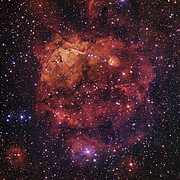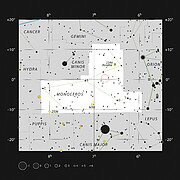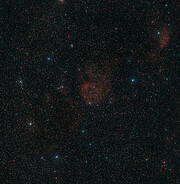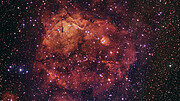Nota de prensa
La nebulosa del Gato sonriente, captada en una nueva imagen de ESO
27 de Junio de 2023

Esta nube naranja y roja forma parte de la nebulosa Sh2-284, y la espectacular y detallada imagen se ha obtenido con datos del VLT Survey Telescope, que se encuentra en el Observatorio Europeo Austral (ESO). Esta nebulosa está repleta de estrellas jóvenes, ya que el gas y el polvo que contiene se condensan para formar nuevos soles. Si echas un vistazo a la nube en su conjunto, es posible que puedas distinguir la cara de un gato sonriendo desde el cielo.
La guardería estelar Sh2-284 es una vasta región de polvo y gas y su parte más brillante, visible en esta imagen, tiene unos 150 años luz (más de 1400 billones de kilómetros) de ancho. Se encuentra a unos 15.000 años luz de distancia de la Tierra, en la constelación de Monoceros.
Ubicado en el centro de la parte más brillante de la nebulosa, justo debajo de la "nariz del gato", hay un cúmulo de estrellas jóvenes conocido como Dolidze 25, que produce grandes cantidades de radiación y vientos fuertes. La radiación es lo suficientemente potente como para ionizar el gas de hidrógeno presente en la nube, produciendo así sus brillantes colores naranja y rojo. En nubes como esta es donde se encuentran los “ladrillos” para la construcción de nuevas estrellas.
Los vientos del cúmulo central de estrellas alejan el gas y el polvo en la nebulosa, ahuecando su centro. Cuando los vientos se topan con bolsas de material más densas, estas ofrecen mayor resistencia, lo que significa que las áreas que hay a su alrededor se erosionan primero. Esto crea varios pilares que se pueden ver, a lo largo de los bordes de Sh2-284, apuntando al centro de la nebulosa, como el del lado derecho de la imagen. Si bien en la imagen estos pilares pueden parecer pequeños, en realidad tienen varios años luz de ancho y contienen grandes cantidades de gas y polvo a partir de los cuales se forman nuevas estrellas.
Esta imagen se ha creado con datos obtenidos por el VLT Survey Telescope (VST), que es propiedad del Instituto Nacional de Astrofísica de Italia (INAF) y está ubicado en el Observatorio Paranal de ESO, en Chile. El VST se dedica a mapear el cielo del sur en luz visible y hace uso de una cámara de 256 millones de píxeles especialmente diseñada para tomar imágenes de campo muy amplio. Esta imagen forma parte del sondeo VPHAS+ (VST Photometric Hα Survey of the Southern Galactic Plane and Bulge, sondeo fotométrico en Hα del plano y el bulbo galácticos con el VST), que ha estudiado unos 500 millones de objetos en nuestra galaxia, ayudándonos a comprender mejor el nacimiento, la vida y la muerte de las estrellas de nuestra Vía Láctea.
Enlaces
- Fotos del VST
- Otras imágenes tomadas con el VST
- Para periodistas: suscríbete para recibir nuestros comunicados embargados y en tu idioma
- Para científicos/as: ¿tienes una historia? Cuéntanos tu investigación
Contactos
Juan Carlos Muñoz Mateos
ESO Media Officer
Garching bei München, Germany
Teléfono: +49 89 3200 6176
Correo electrónico: jmunoz@eso.org
Bárbara Ferreira
ESO Media Manager
Garching bei München, Germany
Teléfono: +49 89 3200 6670
Celular: +49 151 241 664 00
Correo electrónico: press@eso.org
Francisco Rodríguez (Contacto para medios de comunicación en Chile)
Red de Difusión Científica de ESO
y European Southern Observatory
Teléfono: +56-2-463-3151
Correo electrónico: eson-chile@eso.org
Acerca de la nota de prensa
| Nota de prensa No.: | eso2309es-cl |
| Nombre: | Sh2-284 |
| Tipo: | Milky Way : Nebula : Appearance : Emission : H II Region |
| Facility: | VLT Survey Telescope |
| Instruments: | OmegaCAM |
Our use of Cookies
We use cookies that are essential for accessing our websites and using our services. We also use cookies to analyse, measure and improve our websites’ performance, to enable content sharing via social media and to display media content hosted on third-party platforms.
ESO Cookies Policy
The European Organisation for Astronomical Research in the Southern Hemisphere (ESO) is the pre-eminent intergovernmental science and technology organisation in astronomy. It carries out an ambitious programme focused on the design, construction and operation of powerful ground-based observing facilities for astronomy.
This Cookies Policy is intended to provide clarity by outlining the cookies used on the ESO public websites, their functions, the options you have for controlling them, and the ways you can contact us for additional details.
What are cookies?
Cookies are small pieces of data stored on your device by websites you visit. They serve various purposes, such as remembering login credentials and preferences and enhance your browsing experience.
Categories of cookies we use
Essential cookies (always active): These cookies are strictly necessary for the proper functioning of our website. Without these cookies, the website cannot operate correctly, and certain services, such as logging in or accessing secure areas, may not be available; because they are essential for the website’s operation, they cannot be disabled.
Functional Cookies: These cookies enhance your browsing experience by enabling additional features and personalization, such as remembering your preferences and settings. While not strictly necessary for the website to function, they improve usability and convenience; these cookies are only placed if you provide your consent.
Analytics cookies: These cookies collect information about how visitors interact with our website, such as which pages are visited most often and how users navigate the site. This data helps us improve website performance, optimize content, and enhance the user experience; these cookies are only placed if you provide your consent. We use the following analytics cookies.
Matomo Cookies:
This website uses Matomo (formerly Piwik), an open source software which enables the statistical analysis of website visits. Matomo uses cookies (text files) which are saved on your computer and which allow us to analyze how you use our website. The website user information generated by the cookies will only be saved on the servers of our IT Department. We use this information to analyze www.eso.org visits and to prepare reports on website activities. These data will not be disclosed to third parties.
On behalf of ESO, Matomo will use this information for the purpose of evaluating your use of the website, compiling reports on website activity and providing other services relating to website activity and internet usage.
Matomo cookies settings:
Additional Third-party cookies on ESO websites: some of our pages display content from external providers, e.g. YouTube.
Such third-party services are outside of ESO control and may, at any time, change their terms of service, use of cookies, etc.
YouTube: Some videos on the ESO website are embedded from ESO’s official YouTube channel. We have enabled YouTube’s privacy-enhanced mode, meaning that no cookies are set unless the user actively clicks on the video to play it. Additionally, in this mode, YouTube does not store any personally identifiable cookie data for embedded video playbacks. For more details, please refer to YouTube’s embedding videos information page.
Cookies can also be classified based on the following elements.
Regarding the domain, there are:
- First-party cookies, set by the website you are currently visiting. They are stored by the same domain that you are browsing and are used to enhance your experience on that site;
- Third-party cookies, set by a domain other than the one you are currently visiting.
As for their duration, cookies can be:
- Browser-session cookies, which are deleted when the user closes the browser;
- Stored cookies, which stay on the user's device for a predetermined period of time.
How to manage cookies
Cookie settings: You can modify your cookie choices for the ESO webpages at any time by clicking on the link Cookie settings at the bottom of any page.
In your browser: If you wish to delete cookies or instruct your browser to delete or block cookies by default, please visit the help pages of your browser:
Please be aware that if you delete or decline cookies, certain functionalities of our website may be not be available and your browsing experience may be affected.
You can set most browsers to prevent any cookies being placed on your device, but you may then have to manually adjust some preferences every time you visit a site/page. And some services and functionalities may not work properly at all (e.g. profile logging-in, shop check out).
Updates to the ESO Cookies Policy
The ESO Cookies Policy may be subject to future updates, which will be made available on this page.
Additional information
For any queries related to cookies, please contact: pdprATesoDOTorg.
As ESO public webpages are managed by our Department of Communication, your questions will be dealt with the support of the said Department.






